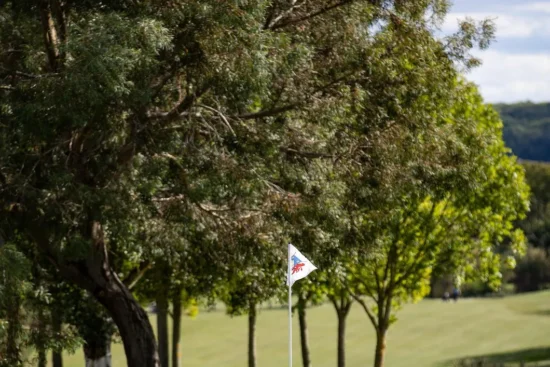
Tragedy on the last hole
On Sunday of the 1999 British Open, Jean Van de Velde stood on the tee of the final hole at Carnoustie as the tournament leader enjoying a seemingly unassailable three-shot lead with only 445 yards to go to achieve the ultimate honor of being crowned champion. Over the previous three days, the French player played impeccable golf and seemed to be in complete control of his game.

It seemed certain that he would become the first French player to win the tournament since 1907, when his compatriot Arnaud Massy won. Van de Velde had made only one double bogey in the first 54 holes of the championship and had birdied the 18th hole in the second and third rounds. Then, with his name already engraved on the Claret Jug (the
famous British Open trophy), the French player, incomprehensibly, committed harakiri.
 After a mediocre drive, the general consensus was that it was best to come up short at the dreaded Barry Burn Estuary. From there it would have required only one relatively easy stroke followed by the luxury of up to three putts to achieve victory in the world’s most important tournament. However, the golf gods decreed otherwise.
After a mediocre drive, the general consensus was that it was best to come up short at the dreaded Barry Burn Estuary. From there it would have required only one relatively easy stroke followed by the luxury of up to three putts to achieve victory in the world’s most important tournament. However, the golf gods decreed otherwise.
Despite the mediocre drive, Van de Velde decided he had a reasonable lie in the rough and that a 2-iron would be enough to reach the green. “I had only 170 yards to get over the water, which wasn’t much,” he explained later, adding, “The ball was sitting so well that I took my 2-iron, but I didn’t hit a good shot.” And so much! The French player’s ball hit the grandstand to the right of the green, flew backwards and then hit the rocks guarding the Barry Burn before coming to a definitive stop in the overgrown rough next to the water.
Explaining his complicated situation at the time, Jean said: “I couldn’t go backwards, I don’t think I could have done anything. The only thing I could do was to hit hard. Obviously, I didn’t hit hard enough.” The ball ended up plunging into the water. The sorry state of affairs that was unfolding before the incredulous and silent spectators turned to farce as Van de Velde took off his shoes and socks and cautiously groped in the water.

For a moment he seemed to have lost his mind, but something akin to sanity prevailed, so he changed his mind and opted to drop. A pitch and putt would still have given him the victory, but the gods were not about to relent.
The wedge shot fell short and after a short flight ended up in the bunker in front of the green. Meanwhile, his playing partner, Craig Parry, who had been the victim of his own share of misfortune in the round, watched the scene in utter disbelief. “I was really hurting for Jean,” said the Australian. “I watched him throw the tournament away after playing excellently for 71 holes. I felt for him,” he added.

The dramatic finish ended when Van de Velde bogeyed for a triple bogey (7 strokes), which led to a play-off against Justin Leonard and Paul Lawrie, and it was the latter who ultimately won the title in the playoff. The configuration of the golf course came in for severe criticism during the week. Davis Love commented acidly, “The Open has the champion it deserves!”.
When the ordeal was over, Van de Velde was peppered with questions from journalists, some of whom could not quite believe their eyes. In the barrage of questions, some of which even hinted at insanity, Jean handled the situation with a wonderful sense of humor, along with a considerable degree of self-censorship.

The golfer who had been the main character in the unforgettable drama brought the matter to a conclusion when he commented: “Maybe it was asking too much of me, but the ball was in a good position. Will you forgive me if next time I use a wedge?
The only problem was that it was highly unlikely there would be a next time. Born in May 1966 in Mont de Marsan, Jean Van de Velde represented his country at all levels of amateur golf and turned professional at the age of 21 with an impressive plus 2 handicap.
The following year he obtained the European Tour card at the Qualifying School, and had to wait five years before experiencing his first triumph on the Tour, when he won the 1993 Rome Masters in a play-off.
Jean Van de Velde’s only victories, the 1993 Rome Open and the 2006 Madeira Open.

That victory, however, was not the beginning of a winning streak, quite the contrary. Between then and the infamous debacle at Carnoustie, his best results were three second places. His second place in the British Open moved him up to thirteenth on the Tour Order of Merit and earned him a spot on the Ryder Cup team that would play at Brookline.
But from then on a downhill journey would begin, which worsened when he injured his knee while skiing and had to undergo two surgeries, and finally lost his card in 2004.
The following year he regained his Tour privileges by finishing second in the French Open, which he played at the invitation of the sponsor, and he tasted victory again in 2006 when he starred in an emotional victory in the Madeira Open. But the decline returned and Van de Velde fell to 107th on the Order of Merit in 2007 and lost his card again in 2008 when he finished the season below 120th place in the European Tour rankings.
Since that fateful Sunday at Carnoustie, Van de Velde, who has just turned 59, has traveled extensively and lived in France, Dubai, Hong Kong and Spain (very close to the Real Club Valderrama).
Jean Van de Velde’s Tour, the Carnoustie for the Alfred Dunhill Links Championship, without getting to stand out.

Jean played on the 1999 European Ryder Cup team at Brookline, he also represented France twelve times in the World Cup of Golf and six times in the Alfred Dunhill Cup. In 2012, UNICEF France named Van de Velde as one of its ambassadors. Van de Velde returned to compete several years at Carnoustie on the occasion of the Alfred Dunhill Links Championship, without remarkable results.
In 2010, eleven years after his fateful finish at the British Open, the French player signed the worst round of the first day: 82 strokes, with eight bogeys and a double bogey, precisely on the 18th hole. It was his worst round at Carnoustie since 1999. Of the six times he played the Dunhill Links after that fateful British Open in ’99, Van de Velde missed the cut four times (2001, 2006, 2008 and 2009) and his best result was in 2005, when he finished 28th.
In 2016 he returned to Carnoustie to compete in the Senior Open. He missed the cut, after posting rounds of +3 and +10.
Andalucía Golf, the latest news of this little world
If you want to know more about Golf news, do not hesitate to visit our website where you will find a variety of information about this world and you can continue reading the magazine.

















Leave a Reply